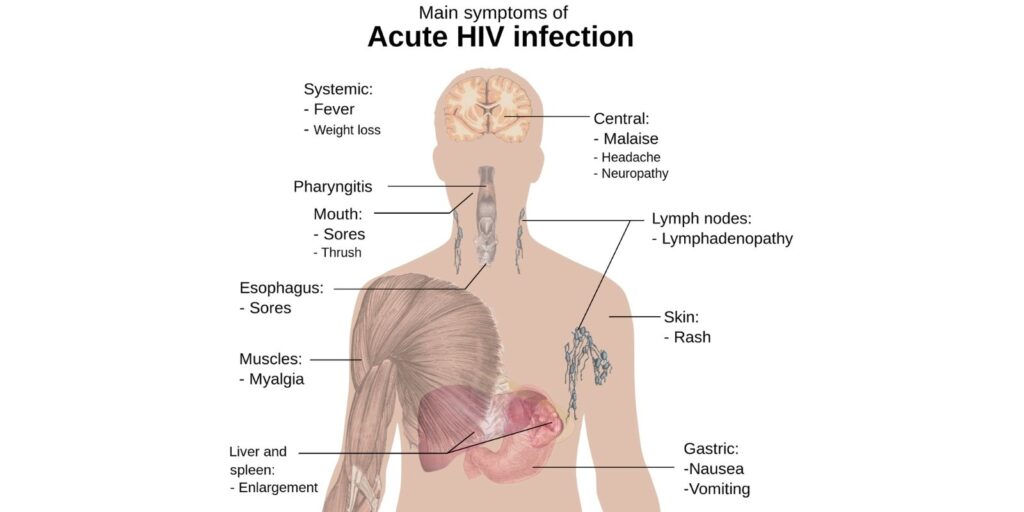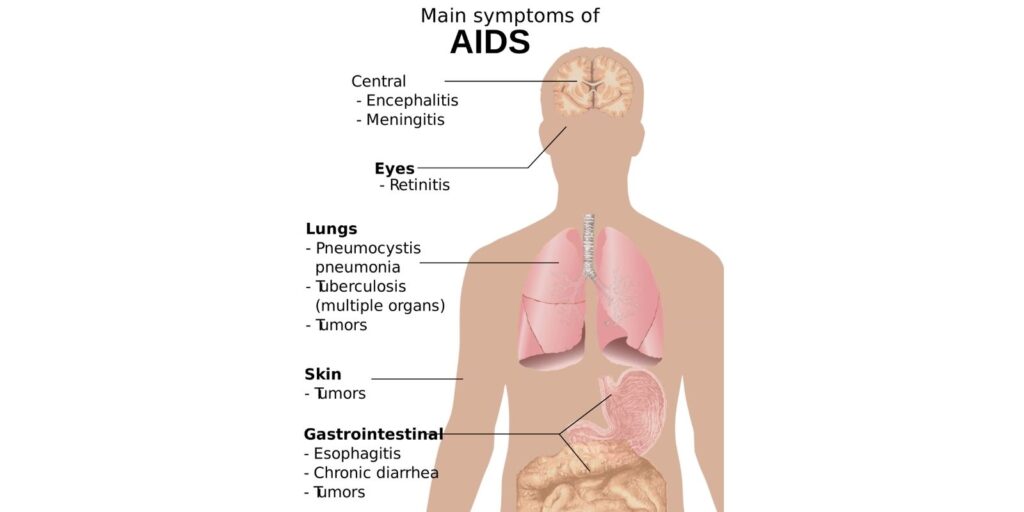Viruses are tiny living organisms, and they require a host body to live and reproduce. Viruses survive by infecting us to get food, and some do it for reproduction. Viruses mainly affect humans to reproduce.
They use our cell’s machinery to multiply, and by doing that, they might harm the very cell that helps in their reproduction. Different viruses affect different cells, and various infections have different capabilities. HIV or Human Immunodeficiency Virus is also among the deadly viruses because our knowledge regarding diseases is limited; therefore, the cure is limited as well.
1. What is HIV?
HIV is a virus that attacks the immune system of humans and leads to a deterioration of the natural defense system in the body. HIV stands for Human Immunodeficiency Virus, and it affects humans through exchange or contact of body fluids or blood.
Our immune system has a robust and effective mechanism to fight bacteria and viruses, but HIV drastically affects the immune response. Therefore, medications and medical care is required for the treatment of HIV.
1.1 How to Differentiate Between HIV and AIDS?
HIV is a virus that might lead to infection; however, AIDS (acquired immunodeficiency syndrome) is a condition that might develop at a later stage of HIV infection. At stage 3, HIV develops to AIDS, and by then, the virus had caused the severe disease to the immune system.
2. Types of HIV
HIV has two types, namely, HIV-1 & HIV-2. However, the commonest one is HIV-1, while HIV-2 is restricted to some areas in Africa. The genetic makeup of the HIV types vary by 55%, and due to cross-reactivity in the antibodies, the risk of misdiagnosis is higher.
2.1 Similarities in HIV-1 and HIV-2
The intracellular replication pathways, clinical effects, and mode of transmission are similar and might lead to acquired immune deficiency syndrome (AIDS).
2.2 Differences in HIV-1 and HIV-2
Although the transmission modes are similar, HIV-1 progresses faster than HIV-2, and it increases the risk of AIDS. HIV-2 has slower progress because it has a lower transmission rate; therefore, the patients remain non-progressors for months or even years.
The immune system of the body is more protective of HIV-2 infection, as the disease lacks rapid progress.
2.3 Subdivisions of HIV-1 and HIV-2 Infection
HIV-1 and HIV-2 are further categorized into subtypes and groups. HIV-1 has three groups, namely, the main group (M group), outlier (O group), and non-M/O or the N group. Among these, the M group is most common and is bound for the HIV epidemic worldwide.
The M group is further categorized into the subtypes; A, B, C, D, F, G, H, J, and K. The subtype B is the dominant form accounting for 12% of HIV-1 infections, and it is mostly reported in Americas, Western Europe, and Australasia.
The HIV-2 infection has two subtypes A and B, that are epidemic, and 8 more subtypes have been identified. The HIV-2 infections of group A are common in West Africa, Europe, Brazil, United States, and India. However, group B HIV-2 infections are only prevalent in West Africa.
3. Signs and Symptoms of HIV
Early detection of the virus improves the quality of life and increases the chances of treatment and survival, so it is essential to identify signs and symptoms of HIV at an initial stage. The symptoms may appear similar to flu at an early stage:
- Headache
- Fever
- Tiredness
- Swollen lymph nodes (swellings in front of your neck, or above your clavicle)
- Sore throat
- Thrush
- Rash
- Joint and muscle pain
- Mouth ulcers
- Genital ulcers
- Night sweats
- Diarrhea
The early symptoms of HIV infection may arise within two weeks or one to two months of exposure and transmission.
However, some people might not display early symptoms, but it is vital to detect the virus. Because the HIV infection is untreated for a longer duration, the illness may progress to stage 3 that poses a challenge towards treatment and life.
This phase of infection is also known as Acute retroviral syndrome. These symptoms may resolve spontaneously, and the patient may not experience any features for many years (average 8-10 years).
The disease starts again after 8-10 years, and by then, there is a good possibility that the disease has progressed to AIDS, and CD-4 counts are less than 200 cells per cubic millimeter.
HIV may present with many opportunistic infections that may include fungal infection, bacterial infection, and in some cases, with cancer of different parts.
4. Stages of HIV infection
HIV is categorized in three states, that are:
| Acute HIV | Chronic HIV | AIDS |
| The individual experiences flu-like symptoms that appear after a few days to a week after contact with the virus | The latent or asymptomatic stage and it can last for several years | The late stage of HIV, when the CD4 cell count decreases to 200 cells/ mm3. It makes the person vulnerable to infections and AIDS condition |
5. Origin of HIV
There are some controversies regarding the time HIV originated and the time it developed in human populations. Even the source of HIV infection remains controversial.
Scientists found a similar virus in monkeys known as SIV (Simian Immunodeficiency Virus), which is similar to HIV (Human Immunodeficiency Virus) in many aspects. Some believe that it spread from monkeys to humans either by hunting or eating monkeys.
The earliest blood sample that confirmed the presence of HIV in humans dates back to 1959 when a man’s blood confirmed the existence of the virus. Hence the proof made the first case in 1959, yet some scientists date it back to as early as 1920 in Congo.
6. Mode of the Spread of HIV
HIV commonly spreads through body fluids, which include breast milk, semen ejaculated from the penis, or vaginal secretions. Rectal secretions also contain HIV. Blood also contains HIV, and unscreened blood transfusions can be a cause of the spread of HIV.
HIV positive mothers can transfer this virus to their baby during delivery, breastfeeding, or in some cases, even before their child is born.
7. Disease Course
Viruses, in general, choose one specific cell in the human body to cause infection as they reproduce and destroy that particular cell and, eventually, the organ. HIV mainly attacks CD-4 T-cells of the body’s immune system.
The human body has defense mechanisms to safeguard the body from different kinds of infectious agents. Skin is the most critical barrier to protect against infections and other harmful substances.
Similarly, the body has other protective measures to safeguard the body from the invasion of viruses. Smaller microorganisms may bypass these protective measures and get access to either blood or target organs. The body has immune cells that protect cells of the human body from these organisms.
The cells of the immune system that deal explicitly with viruses include “natural killer cells” and T-cells. T-cells are further divided into CD-4 T-cells and CD-8 T-cells. CD-8 cells are the artillery of the immune system, and once they recognize a cell that is harmful to the body, they will attack and destroy that cell even if it is one of the body’s cells.
The drawback to their action is that they cannot prevent the same microorganism from causing the infection again. Here the CD-4 cells play a definitive role, as they are equipped with the ability to generate specialized cells.
These CD-4 cells can remember the type of microorganisms that cause an infection to prevent the disease in the future by destroying the current virus. These cells, along with fighting the infection, also prevent cancer cells from developing in the body.
HIV, being a smart rival, attacks CD-4 cells and gradually destroys the body’s most important cells to protect the body from many infections. Although it prolongs over the years, once robbed of the immune system, the patient is vulnerable to almost any virus that enters the body.
Not only that, but patients may develop cancer once the immune system is destroyed.
The transformation from HIV infected to AIDS is when the body’s CD-4 count drops below 200 cells per cubic millimeter of blood. However, the normal values are 500 – 2000 cells per cubic millimeter of blood.
HIV once enters the body from exposure, and it follows an immediate and a long-term course. Initial or immediate infection can either be asymptomatic, which means the person wouldn’t display symptoms and is neither aware if he/she is infected.
The person might develop a flu-like illness with few features that are not common with the common flu.
8. Prevention from HIV
To prevent HIV, healthcare professionals should educate people regarding safe sex practices (use of a condom, avoid oral sex). People should limit sexual partners because the virus can be deadly in the long run.
It is essential to screen pregnant mothers for HIV to prevent transmission to the unborn baby. Intravenous drug users (IV) who share needles can also get infected from the exchange of needles.
9. Treatment
There have been advancements in the treatment procedures for HIV/AIDS.
Antiretroviral Therapy is the mainstay of treatment, which effectively delays and prevents people from developing AIDS. Pre-exposure prophylaxis and post-exposure prophylaxis treatments help to avoid transmission infection even if they had contact with an infected person’s blood or body fluids.
Repeated tests, continuous treatment is the key to keeping this virus at bay and enjoying a healthy life.
Contact your healthcare provider if you come in contact with someone diagnosed with HIV/AIDS or even if you suspect exposure to HIV/AIDS.











It’s very informative thanks Dr Mehdii